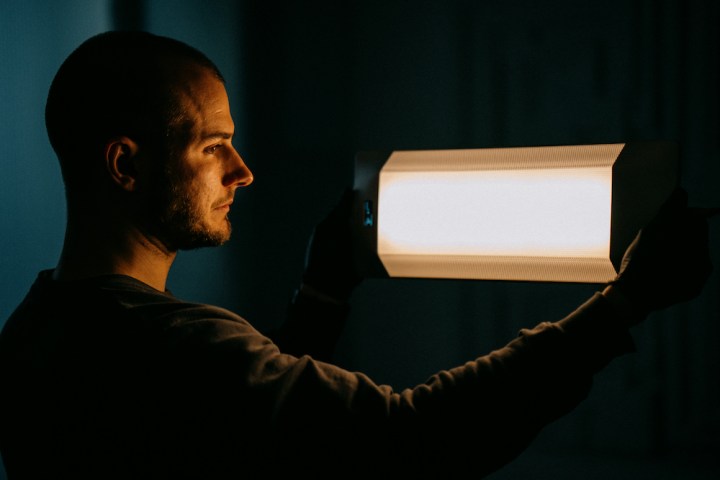
Between the amount of time most of us spend looking at screens, the need to pack so much into a day, and the design of most housing providing bright artificial lights, it’s no easy job to settle into a healthy sleep routine. But if you think it’s hard to do that on Earth, imagine how much harder it is to get a good night’s sleep in space.
The astronauts on the International Space Station (ISS) have to deal with a routine completely disconnected from the rising and setting of the sun, as well as handling unique environmental challenges like low gravity and strict confinement. Studies show that astronauts struggle to get enough good quality sleep, which can lead to both health problems and reduced efficiency in their work.
Most of the work done to promote astronaut health is focused on physical activities like exercise to prevent muscle wasting or scheduling constraints like making sure they have time off from their busy workload to relax. For a long time, the environment that the astronauts lived and worked in was designed with purely pragmatic considerations in mind, with little room for aesthetics. But now, we’re starting to think about how design can help astronauts to be happier and healthier.
It would be prohibitively expensive to expand or radically change the spaces of the ISS, but one idea to help astronauts rest and work better is a seemingly simple one: just change the lighting. That’s the goal of an experiment by a group of Danish architects who are sending a new lighting system to the ISS for testing, with the hope it can improve astronauts’ sleep and mood. We spoke to lead architect Sebastian Aristotelis of SAGA to learn more.
The role of the environment
The human body’s circadian rhythm is primarily set by the amount of light we are exposed to, as our bodies take the presence of bright light as a signal to wake up and its absence as a cue to sleep. That’s why organizations like the CDC advise people to avoid looking at sources of bright blue light like phone screens before bed and to make sure to get some light shortly after waking to help us start the day.
This helps to set internal biological rhythms which are important for everything from hormone production to brain activity. But the presence of artificial light upends this system, altering circadian rhythms and contributing to sleep problems.

This is an even worse problem for astronauts, who already have to deal with sleep problems and have reported sleeping as little as five or six hours per night, far less than the eight to 10 hours recommended for adults. The current lighting system on the space station allows some adjustments by the astronauts based on their needs, but it is very much a functional system designed around providing adequate light to work rather than being designed to promote healthy sleep patterns.
Danish design firm SAGA has been working on combining their knowledge of human-centered design with experience in design for space missions to create a lighting system called Circadian Light, which will be sent to the ISS this summer to be tested by Danish astronaut Andreas Mogensen when he arrives there for a six-month mission later in the year.
The problem of monotony
The principles of designing lighting around circadian rhythms are well understood: lots of bright light including blue wavelengths in the morning, and dimmer lighting with no blue wavelengths in the evenings. The designers took their inspiration directly from nature when deciding what types of light would be most beneficial. The lamp they developed has three different faces which emit light at different wavelengths and intensities to mimic the changes in light quality seen throughout the day on Earth.
That means there’s potential there to change the feel of a room. “Light is the most accessible way of changing the appearance of an entire room,” Aristotelis said. “You get a lot of bang for the buck in terms of changing the light.”
Lighting has the potential to do far more than just brighten and dim to signal waking and sleeping though. It’s hard to imagine, but one of the big psychological challenges that astronauts have to face is boredom. The monotony of the environment is relentless, with factors like the available food, the temperature, the lighting, and the air quality remaining consistent for weeks and months at a time. It’s common for astronauts to be thrilled and excited to be in space for the first few weeks or months of their mission, but soon the same-y-ness of each day starts to wear.

Most of those things can’t be changed for safety reasons, but lighting can be. And lighting within the crew quarters, where the experiment will be, does need to be practical and functional but there’s also more room for it to be adjusted for aesthetics than there would be on other parts of the station.
So the Circadian Lighting system doesn’t simulate the exact same sunrise – sunshine – sunset cycle each day. Some mornings will see a dimmer, more muted set of colors, while other mornings will see blazing, beautiful shades. That variability is actually more engaging than having the same pattern repeated each day, even if some days are more pleasing than others.
“What you really need to break monotony is not necessarily good stimulation or comfortable stimulation, it is just stimulation,” Aristotelis said. “If it has been a moderate temperature for 100 days, I’m sure a cold day would actually be quite nice.”
Small intervention, big impact
The aim is for the lamp, which will be installed in Mogensen’s crew quarters, to help him both sleep better at night and wake up with more energy. Alongside the test on the ISS, an experiment will be performed on Earth to test out the system’s efficacy as well.
If the results are promising, this approach could help to improve the day-to-day lives of astronauts with only minimal cost. Sure, having more room and privacy would be nice, but that isn’t practically achievable without spending huge amounts to expand the station. But installing lights is relatively easily done.
“The return on investment in terms of well-being is very high,” Aristotelis said. “Especially because sleep is such a wonderful mechanism of the human body.”
Adjustments can also be made to allow astronauts to have free time in the evenings for tasks like calling up family or friends or working on personal projects, the duration of the simulated sunset is extended. While a sunset on Earth generally lasts around 20 minutes, on the ISS the lighting system will extend this period as needed before the astronaut goes to bed.

There are future ideas to make the system even more dynamic too. Currently, the lamp cycles through different preset patterns to give some daily variation. But future systems could be designed to respond to environmental conditions, such as changing the lighting conditions when the amount of radiation outside the station is high. By integrating lighting along with other sensory modalities like sound and smell, a more dynamic environment could be created which actually informs astronauts about the situation around them.
“Imagine that there were speakers that made it sound windy if there was a lot of radiation hitting the habitat. Then you would use one of your intuitive senses to understand that there was something that you needed to protect yourself from,” Aristotelis said. “That’s where we would like to go, so the light is not random, it is actually informed by the environment.”
Lighting the space station and beyond
Designing for the well-being of astronauts is important for the ISS, but it’ll be even more important for long-duration space missions beyond Earth orbit. With plans to soon send NASA astronauts for months-long missions on the moons, and longer-term visions to explore and even settle on other planets, we’ll need to find ways to recreate Earth-like conditions for explorers to be comfortable and perform at their best.
That means space design can’t only consider the practical needs of food and water, but will need to take into account the human needs for variety, comfort, and interest as well. Many of the things we need to explore the stars are the same things we take for granted in our home environment.
“I love that about designing for humans in space,” Aristotelis said. “The human is the same human on Earth as it is in space. We need the same amount of stimuli.”
Editors' Recommendations
- China’s space station was hit by space junk
- Crewed Soyuz launch to space station suffers rare late abort
- How to watch Crew-8 arrive at the space station tonight
- How to watch SpaceX Crew-8 launch to the space station tonight
- NASA astronauts need good weather for Crew-8 launch. Here’s how it’s looking





